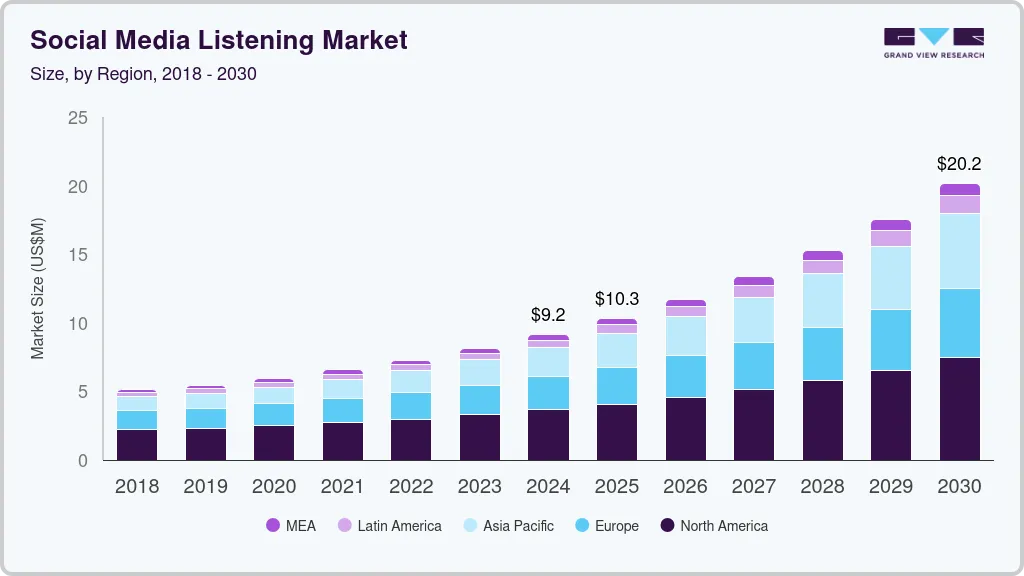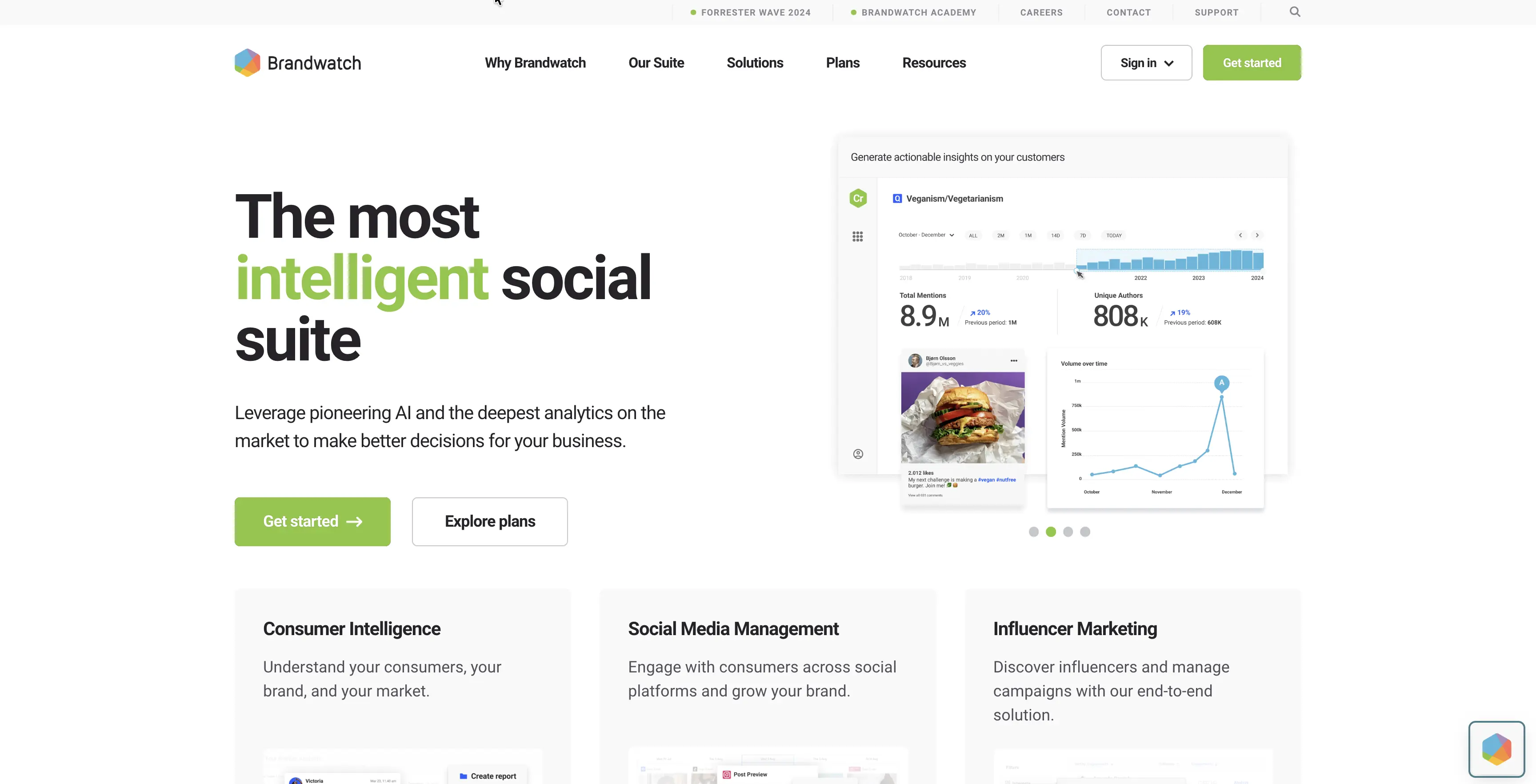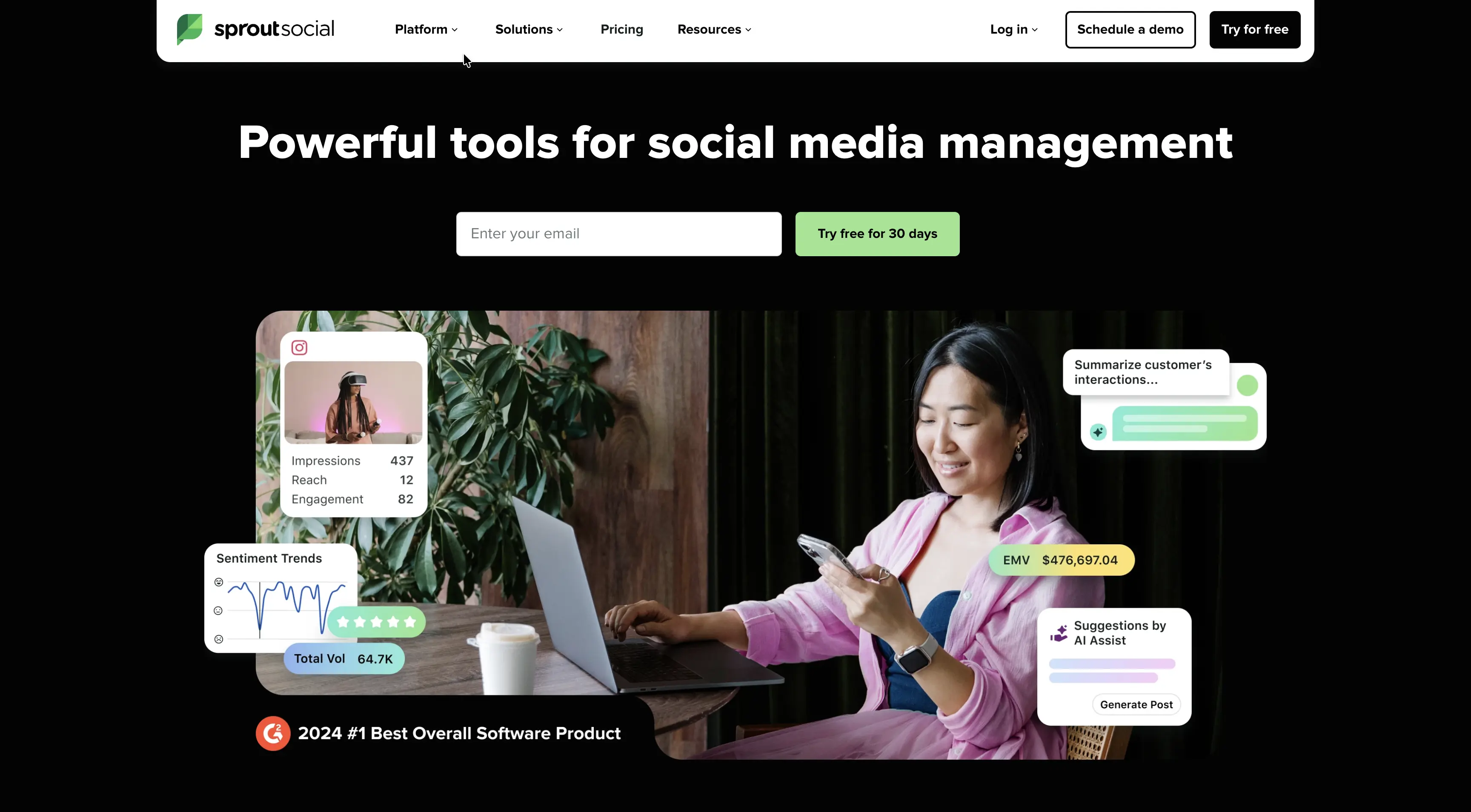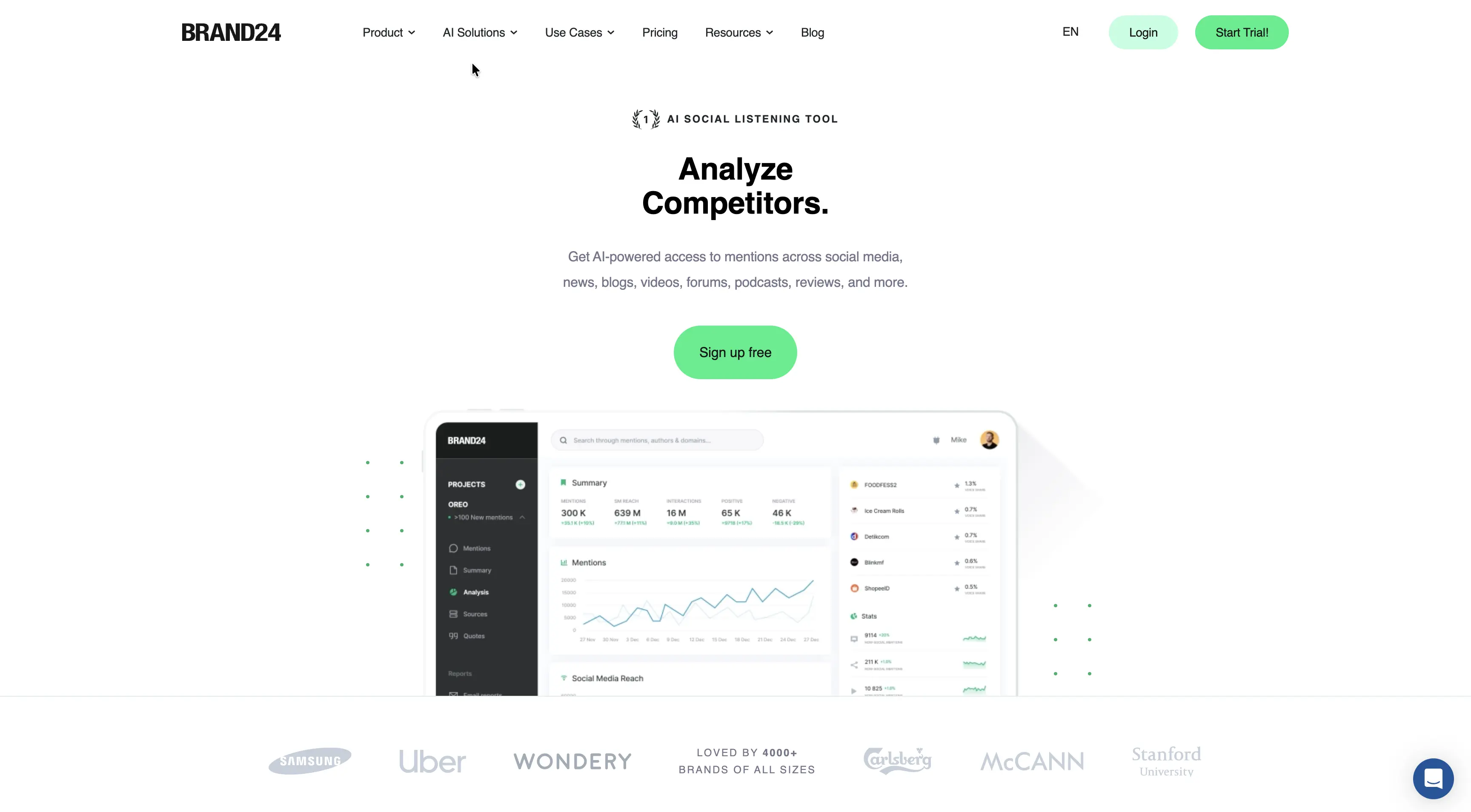Top 10 Tools for Social Listening in 2026 (B2B Buyer's Guide)
Discover the best tools for social listening in 2026. Compare pricing, features, and B2B capabilities of the top 10 platforms. Find the perfect fit.
Discover the best tools for social listening in 2026. Compare pricing, features, and B2B capabilities of the top 10 platforms. Find the perfect fit.

Social listening has evolved from a nice-to-have marketing tactic to a mission-critical business intelligence function. In 2026, the most successful B2B companies don't just monitor social media—they extract strategic insights that drive revenue, protect brand reputation, and inform product development.
The social media listening market reflects this shift. According to Grand View Research, the global market reached USD 10.32 billion in 2025 and is projected to grow at a CAGR of 14.3% through 2030.

This explosive growth is driven by three key factors:
For B2B teams, social listening offers unique advantages. Unlike B2C brands focused on viral moments, B2B companies use these tools to identify buyer intent signals, track industry trends, and engage decision-makers on professional networks like LinkedIn.
But here's the challenge: not all social listening tools are created equal. Some excel at consumer-focused platforms like TikTok and Instagram. Others provide deep LinkedIn coverage and CRM integration that B2B teams actually need. Some drown you in data, while others deliver actionable intelligence.
In this guide, we'll cut through the noise and compare the top 10 tools for social listening for 2026. You'll learn which platforms offer the best B2B features, how pricing models compare, and which tool matches your team's specific needs.
Before diving into specific platforms, let's establish a clear decision framework. The right tool for your organization depends on several critical factors.
Not all social listening tools monitor the same platforms. For B2B teams, LinkedIn coverage is non-negotiable. Yet many tools provide limited or sampled LinkedIn data.
What to look for:
B2B insight: If your buyers are active on LinkedIn and participate in industry forums, choose a tool with robust professional network coverage. Consumer-focused tools often fall short here.
2026's best social listening tools use AI to deliver deeper insights. Look beyond positive/negative sentiment scoring.
Advanced AI features to prioritize:
According to recent research from eMarketer (2025), social listening has become a top strategic priority for marketers this year, ranking alongside AI-driven personalization. The tools that win in 2026 are those that turn raw data into strategic intelligence automatically.
Social listening pricing varies dramatically. Traditional enterprise tools lock you into annual contracts with per-user fees ranging from $10,000 to $100,000+ annually.
Pricing models to understand:
B2B consideration: Calculate your true cost per insight, not just the sticker price. A $50,000 annual contract that requires a full-time analyst to interpret data may cost more than a $15,000 AI-powered solution that delivers ready-to-use insights.
Your social listening tool should integrate seamlessly with your existing systems.
Essential integrations for B2B teams:
For deeper insights on how social listening supports your overall sales strategy, check out our guide on AI sales tools and how they integrate with signal intelligence.
Some social listening platforms require weeks of setup, Boolean query expertise, and dedicated analysts. Others offer pre-built templates and AI-powered configuration.
Questions to ask:
The best tools for social listening in 2026 deliver value within days, not months.
Here's a quick reference comparing pricing, B2B focus, AI capabilities, and integrations:
We analyzed coverage, AI capabilities, pricing, and B2B-specific features to compile this list. Each tool serves different use cases and team sizes.
What makes it special: Trigify is purpose-built for B2B teams who need actionable intelligence, not data dumps. Unlike legacy tools that monitor everything, Trigify uses AI agents to identify high-value signals (buyer intent, competitor moves, product feedback) and route them to the right teams instantly.
Key features:

Pricing: Pay-as-you-go model. No enterprise lock-in. Perfect for startups to mid-market companies.
Best for: B2B marketing teams, sales development reps, product managers, and growth teams who need fast, actionable insights without hiring an analyst.
What users say: "Trigify has been a game changer when it comes to monitoring social conversations. As well as automating warm lead outreach from LinkedIn." (Mark Fershteyn, CEO, Recapped.io)
Why B2B teams choose Trigify:
Learn more about Trigify's approach to social listening and how it compares to legacy alternatives like Hootsuite and Sprout Social.
What makes it special: Brandwatch offers enterprise-grade social listening with massive data coverage. It excels at consumer research and includes influencer marketing capabilities.
Key features:

Pricing: Custom enterprise pricing (typically $50,000+ annually)
Best for: Large enterprise brands with dedicated social media teams and big budgets.
Limitations: Relies on data sampling. Limited TikTok monitoring (brand handles only). Facebook/Instagram coverage depends on pages added by clients.
For B2B teams evaluating Brandwatch, consider whether you need consumer research depth or sales intelligence. Learn more in our Brandwatch alternative comparison.
What makes it special: Sprout Social combines social media management, publishing, and listening in one platform. It's ideal for teams that need to manage multiple social accounts while monitoring conversations.
Key features:

Pricing: Costs at $199/seat/month (billed annually). Social listening features available on higher-tier plans.
Best for: Marketing teams managing publishing + monitoring in one tool.
Limitations: Less sophisticated listening capabilities compared to dedicated platforms. Limited historical data on lower plans.
What makes it special: Brand24 delivers comprehensive monitoring at affordable prices. It's a solid choice for small businesses and agencies managing multiple clients.
Key features:

Pricing: Starts at $149/month (billed annually). Multiple tiers available.
Best for: Small to medium businesses, marketing consultants, agencies.
Limitations: May struggle with high-volume monitoring. Limited advanced analytics compared to enterprise platforms.
What makes it special: Meltwater combines earned media monitoring with social listening. It's particularly strong for PR professionals who need to track traditional media alongside social conversations.
Key features:

Pricing: Custom enterprise pricing
Best for: PR and communications professionals, especially those operating in international markets.
Limitations: Facebook/Instagram monitoring relies on limited API access. LinkedIn monitoring uses sampled beta program. TikTok limited to brand handles.
What makes it special: Talkwalker offers image and video recognition technology, making it ideal for brands with strong visual content.
Key features:

Pricing: Enterprise pricing starting around $9,600 annually
Best for: Marketing teams focused on content performance and trend identification.
Limitations: TikTok monitoring discontinued (September 2024). LinkedIn monitoring uses sampled beta. Requires Boolean search expertise.
What makes it special: Awario offers real-time monitoring at affordable prices, perfect for individual consultants and solopreneurs.
Key features:

Pricing: Starts at $29/month (billed annually)
Best for: Solo practitioners, small businesses, freelance marketers
Limitations: Smaller data coverage. Slower processing speed for high-volume monitoring.
What makes it special: Hootsuite is a comprehensive marketing platform that combines social listening with other
Key features:

Pricing: Custom enterprise pricing
Best for: B2C Marketing teams needs content scheduling as well as listening.
What makes it special: Keyhole specializes in hashtag tracking and campaign measurement, making it ideal for social media marketers running hashtag campaigns.
Key features:

Pricing: Starts at $79/month
Best for: Social media managers running influencer and hashtag campaigns
What makes it special: Mention offers a simple way to track mentions of your brand, products, or competitors across social, news, and the web in near real time, without needing a heavy enterprise setup.
Key features:

Pricing: Enterprise starting at $599
Best for: Enterprise teams needs solid social listening for their brand.
Choosing the right tool is just the beginning. Here's a proven framework for implementing social listening successfully.
Week 1: Define Your Objectives
Week 2-3: Tool Configuration
Week 4: Establish Workflows
Week 5-6: Train Your Team
Week 7-8: Start Listening Actively
Week 9-10: Refine Your Approach
Week 11-12: Scale and Expand
Pro tip: For B2B teams, consider how social listening integrates with your broader sales trigger strategy. Learn more in our guide to top sales trigger tools.
Even experienced teams make these critical errors when evaluating tools.
The cheapest tool isn't always the best value. A $99/month platform that requires 20 hours of manual analysis per week actually costs more than a $500/month AI-powered solution that delivers insights automatically.
Better approach: Calculate total cost of ownership, including staff time, training, and integrations.
Social listening tools that don't connect to your CRM, sales tools, or communication platforms create data silos. Insights that live only in a dashboard never drive action.
Better approach: Require native integrations with your core business systems. Test data flow before committing.
Many popular social listening tools were built for consumer brands. They excel at TikTok and Instagram monitoring but provide limited LinkedIn coverage and lack B2B-specific features like intent detection or CRM enrichment.
Better approach: Prioritize platforms designed for B2B use cases. Look for robust LinkedIn monitoring, professional network coverage, and sales intelligence features.
Basic sentiment analysis (positive/negative/neutral) doesn't provide enough insight in 2025. Modern teams need emotion detection, intent classification, and automated trend identification.
Better approach: Test the AI features hands-on. Ask for examples of how the tool uses AI to surface actionable insights, not just categorize data.
Many social listening vendors push annual contracts without adequate trial periods. This locks you into a tool that may not meet your needs.
Better approach: Insist on a meaningful trial (at least 14 days) with full feature access. Run real-world scenarios during the trial period.
Different teams use social listening for different purposes. Here's how to match tools to specific use cases.
Best tools: Trigify, ZoomInfoWhy: These platforms identify buying signals and intent data, helping sales teams engage prospects at the right moment.
Best tools: Brand24, Mention, BrandwatchWhy: Real-time alerts and comprehensive coverage help protect brand reputation and respond to issues quickly.
Best tools: Trigify, Brandwatch, TalkwalkerWhy: Track competitor mentions, campaign performance, and market positioning to inform strategic decisions.
Best tools: Talkwalker, Meltwater, BrandwatchWhy: Historical data and trend identification help teams spot emerging opportunities and shifts in consumer behavior.
Best tools: Sprout Social, HootsuiteWhy: Combined publishing and listening features streamline workflow for marketing teams managing multiple accounts.
Social monitoring tracks brand mentions in real time (reactive). Social listening analyzes conversation patterns, sentiment, and trends to inform strategy (proactive). Monitoring answers "what's being said?" while listening uncovers "why it's being said?"
Pricing ranges from $30/month (basic tools like Awario) to $100,000+ annually (enterprise platforms like Brandwatch). Most B2B-focused tools cost between $5,000 to $30,000 annually. Pay-as-you-go options like Trigify offer flexible pricing without long-term commitments.
Absolutely. B2B teams use social listening to identify buyer intent signals, track decision-maker activity, and engage prospects at the right moment. Tools like Trigify are specifically designed to support sales teams with actionable intelligence.
For more on how social listening supports modern sales strategies, check out our guide on best social listening tools for B2B teams.
For B2B teams, prioritize tools with strong LinkedIn coverage, CRM integration, and intent detection capabilities. Trigify, ZoomInfo, and Sprout Social excel in B2B contexts. Avoid consumer-focused platforms that lack professional network monitoring.
Google Alerts provides basic mention tracking but lacks sentiment analysis, competitive benchmarking, and real-time insights. It's fine for personal brand monitoring but insufficient for business intelligence. Professional social listening tools offer exponentially more value.
The best tools for social listening in 2025 transform how B2B teams understand their markets, engage customers, and drive revenue. But choosing the right platform requires careful evaluation of coverage, AI capabilities, pricing, and integrations.
For most B2B teams, we recommend starting with these criteria:
If you're a B2B marketing, sales, or product team, Trigify offers the fastest path to actionable intelligence. Unlike legacy tools built for consumer brands, Trigify uses AI agents to identify high-value signals and route them to your CRM, Slack, or sales tools automatically. No data dumps. No analyst required. Just signals that drive revenue.
Ready to see the difference? Start listening with Trigify with no monthly commitment required.